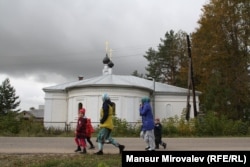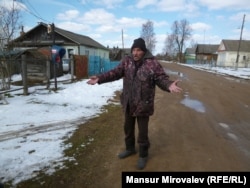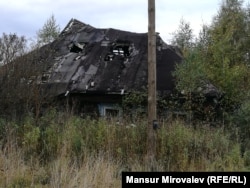ROZHDESTVENO, Russia -- Nazim Soliev is confident that he's good for Russia.
Or more specifically, the 35-year-old native of Tajikistan, the most impoverished of Central Asia's five former Soviet republics, says his presence here, 200 kilometers northwest of Moscow, is good for his adopted homeland.
"'Better you than the Chinese,' that's what my ex-boss told me," the small-framed Soliev says between double shifts as a stoker at the village school, earning him around $250 a month, nearly twice the average Tajik wage.
The "you" is a reference to Soliev, who speaks fluent Russian and also routinely quotes ancient Persian thinker Omar Khayyam's poems in Farsi, a linguistic sibling of his mother tongue, and 46 other families whose resettlement from Tajikistan over the past decade almost doubled Rozhdestveno's aging population of about 200.
Half of the students in Soliev's school are their raven-haired children, and their wives, in long skirts and head scarves, shop for groceries at a store next to the Orthodox church.
The arrival to urban centers and the countryside of Soliev and millions of other mostly Muslim labor migrants from Central Asia is at the center of what could emerge as Russia's most radical ethnic makeover in centuries.
And some residents of Rozhdestveno and nearby villages speak caustically of the immigrants and forebodingly of an uncertain future.
"In 10 years, the village will either disappear or become foreign," says retiree Viktor Yerofoeyevich, declining to give his last name. He is a resident of the neighboring village of Bortnikovo, where a paltry 12 houses have full-time residents.
Polls point to fears among many of Russia's 142 million people of an uncontrolled influx of migrants eager to snatch up jobs and wildly tilt the country's demographics in favor of the newcomers.
Vyacheslav Postavnin, a former deputy director of Russia's Federal Migration Service who now heads the 21st Century Migration Fund, a Moscow-based think tank, compares it to the storied Mongol invasion of the 13th century that was followed by Islamization and the settling of former nomads in what is now southern Russia.
"The last bastion is the quick construction of Orthodox churches," Postavnin says of ethnic Russians' mistrust of the cultural and religious implications of immigration, "because the number of adherents of Islam is growing."
Four-fifths of Russians say the Kremlin "must limit" the flow of migrants, and two-fifths believe migrants should live in "specially assigned areas," according to a survey last year by state-run pollster VTsIOM.
And more than one in four Russians feels "irritation, dislike, or fear" specifically toward Central Asians, according to a more recent survey by independent pollster Levada.
Bucking A Trend
In its recent Revision Of World Urbanization Prospects report, the United Nations predicted that the current decline in Russia's rural population would accelerate in the coming decades, from nearly 37 million now to just 22 million Russians residing in the countryside by the year 2050.
Stretched along the road between the ancient city of Tver and the Volga River, Rozhdestveno and a cluster of smaller villages around it exemplify the agony of Russia's countryside.
Here, as in many rural areas mired in joblessness since the post-Soviet collapse of collective farms, decimated by low birthrates and migration to big cities, and barely held together by potholed roads, there is a perception that this kind of national heartland is no longer a pillar of Russian identity, prosperity, and tsarist-era expansion from the Baltic to the Pacific.
The trends have been accompanied by cutbacks in the number of village hospitals, schools, and administrative resources that further encourage locals to flee dwindling villages. Almost 36,000 Russian villages, or one in four, are home to 10 or fewer residents, and 20,000 more have been abandoned altogether, according to the latest Russian census, conducted in 2010.
Rozhdestveno is lucky to be larger than the nearby villages, but fallow fields covered with birch and pine saplings and poisonous giant hogweed surround it in every direction. The saplings herald the return of dense forests from which these villages were carved out centuries ago.
While the elderly in the area are forced to make do on meager pensions, many of the younger residents who haven't left for the city subsist on potatoes from backyard gardens and pick mushrooms and berries to supplement their incomes. They sell whatever they can pick to middlemen from Tver or to affluent neighbors -- frequently dacha owners from big cities who only show up in summer.
"I can sell mushrooms, sell cranberries. How else can I earn money?" says Vladimir, a jobless man from the village of Nesterovo, lisping through missing teeth. Clad in a greasy jacket and standing on a dirt road, he sums up his quarter century since the Soviet collapse.
"All of our household economy was destroyed, all the animal farms," he says. "Every old lady used to have sheep, cows. Now, no one has any. Even chickens are gone."
'Not Afraid To Work'
Almost all of Rozhdestveno's Tajik families hail from Gorno-Badakhshan, an especially poor, mountainous region that accounts for nearly half of Tajikistan's territory. Tajiks were early and eager labor migrants to post-Soviet Russia, and hundreds of thousands now have citizenship there, officials say.
While it didn't distinguish between Russian nationals and foreigners, the last nationwide census, in 2010, showed fourfold increases in the number of ethnic Tajiks and Kyrgyz in the Russian countryside, although there was a steep decline in the number of ethnic Uzbeks.
But the census generally excludes temporary labor migrants, according to Yevgeniya Chernina of the Center of Labor Studies at Moscow's Higher School of Economy, of which there are millions, on and off the books.
The Tajik men around Rozhdestveno -- from teenagers to forty-something men -- are said to be generally eager to accept any employment opportunity that presents itself. They compete with locals in picking mushrooms and berries, and work at a nearby sawmill, on farms and construction sites in Tver, and drive cabs and buses.
"They're not afraid to work," Mayor Dmitry Kirdanov says. "It's a helpful difference from the native population."
Immigrants renovated several three-story apartment buildings that stood empty after the demise of the village's collective farm, bought up dilapidating wooden houses, and enrolled three dozen children in school -- doubling the number of students and providing teachers with more work.
There have been inevitable tensions, but locals say they have generally been tackled before they were allowed to fester.
The imposing, taciturn leader of Rozhdestveno's Tajik community routinely finds himself thrust into the center of such quarrels.
Pairavsho, as he is known, manages a storage facility in Tver and arbitrates disputes between Tajiks and locals, a cultural holdover from the common Central Asian practice of tapping the wisdom of elders.
"If there's a misunderstanding, they come to me, and we sort things out right away," the father of two says on a Sunday evening, as dozens of Tajiks play soccer on the field in front of him.
Kirdanov cites an example, saying the immigrants' children "brought a specifically [Central] Asian attitude to women" that some locals found objectionable. In that case, he says, a "conference" was convened to prevail upon the immigrants and soon the boys "stopped treating girls rudely."
'Better Off In The Village'
Some of the immigrants' personal trajectories fit patterns described by Shukhrat Ganiev, a labor migration expert with the Humanitarian Rights Center, a think tank in the central Uzbek city of Bukhara. He has made two extensive trips across Russia since 2000 to document the emergence of what he calls "Uzbek villages" there.
Village officials or farmers in northern regions and Siberia frequently allow labor migrants to squat in abandoned houses and help them get work and residency permits, he says, sometimes inducing nearly whole villages to follow.
"Usually, this is a perennial practice with further integration into the local society," Ganiev says in a reference to migrants who get Russian passports and send their children to Russian-language schools.
Other migrants are hired as seasonal farmhands, he says, mostly in southern Russian regions with booming, industrialized agriculture, and return home in winter.
Even more often, Ganiev says, migrants working in big cities move their families to the countryside because of lower rent and food costs and a safer, healthier environment.
"They're better off in the village," says Rovshan Khushvaktov, a 28-year-old cabbie who arrived four years ago from the central Uzbek city of Bukhara. "It's so hard to keep an eye on children in Moscow."
His wife and three children live in a small rented house in the village of Khoroshevo, some 180 kilometers southwest of Moscow. He sleeps in his white Hyundai between 18-hour shifts and tries to visit them each week.
Once they get Russian citizenship, many migrants become an important asset for local politicians.
In Rozhdestveno, where the overwhelming majority of Tajiks boast red Russian passports, Pairavsho declines to discuss his community's political preferences, saying only that they "take part in every election."
But the indications are that they vote overwhelmingly for the ruling United Russia party.
"Through their leaders, we always get a high turnout," Kirdanov says in a reference to influential elders like Pairavsho.
"All sorts of outside political carpetbaggers tried to use them," he adds, "but now they trust the [Kremlin's] power, and openly say they won't sell their political favors anymore."










